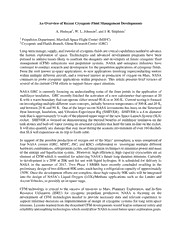
NASA Technical Reports Server (NTRS) 20170001812: An Overview of Recent Cryogenic Fluid Management Developments PDF
Preview NASA Technical Reports Server (NTRS) 20170001812: An Overview of Recent Cryogenic Fluid Management Developments
An Overview of Recent Cryogenic Fluid Management Developments A. Hedayat1, W. L. Johnson2, and J. R. Stephens1 1 Propulsion Department, Marshall Space Flight Center (MSFC) 2 Cryogenic and Fluids Branch, Glenn Research Center (GRC) Long-term storage, supply, and transfer of cryogenic fluids are critical capabilities needed to advance the human exploration of space. Technologies and advanced development programs have been pursued to address issues likely to confront the designers and developers of future cryogenic fluid management (CFM) subsystems and propulsion systems. NASA and aerospace industries have continued to conduct research and development for the propulsion applications of cryogenic fluids. From the well known in-space applications, to new applications involving superconducting motors within multiple different aircraft, and a renewed interest in production of oxygen on Mars, NASA continues to probe cryogenic applications within propulsion. This article presents brief reviews of several of the current CFM efforts to support future space missions. NASA GRC is currently focusing on understanding some of the finer points in the application of multilayer insulation. GRC recently finished the activation of a new calorimeter that operates at 20 K with a warm boundary that can operate either around 90 K or at 300 K. Current testing is focused on investigating multiple different seam concepts, initially between temperatures of 300 K and 20 K, and between 20 K and 90 K. One of the larger recent NASA investments has been on the Structural Heat Intercept, Insulation, and Vibration Experiment Rig (SHIIVER). SHIIVER is a 4 m diameter tank that is approximately ½ scale of the planned upper stage of the new Space Launch System (SLS) rocket. SHIIVER is focused on demonstrating the thermal benefits of multilayer insulation on the tank domes and boil-off vapor cooling on structural cylinders that hold the tank in-line on the rocket. It will also quantify any damage that may incur during the acoustic environment of over 160 decibels that SLS will experience on its trip to Earth orbit. In support of the possible production of oxygen out of the Mars’ atmosphere, a team comprised of four NASA centers (GRC, MSFC, JSC, and KSC) collaborated to investigate multiple different hardware combinations, refrigeration cycles, and integration techniques to minimize power and mass of the storage and liquefaction system. Moreover, high efficiency, high capacity cryocoolers are an element of CFM which is essential for achieving NASA’s future long duration missions. Currently in development is a 20W at 20K unit for use with liquid hydrogen. It is scheduled for delivery to NASA in the summer of 2017. Two Phase I SBIRS have recently concluded resulting in the preliminary design of two different 90K units, each having a refrigeration capacity of approximately 150W. Once the development efforts are complete, these high capacity 90K units will be integrated into the design of NASA’s Liquid Oxygen (LOX)/Methane applications such as the Lander and Ascent Vehicles, or possibly an in-space stage. CFM technology is critical to the success of missions to Mars, Planetary Exploration, and In-Situ Resource Utilization (ISRU) for cryogenic propellant production. NASA is focusing on the development of CFM technologies needed to provide necessary data and relevant experience to support informed decisions on implementation of design of cryogenic systems for long term space missions. Lessons learned from the described CFM developments would lead to enhanced safety and reliability and enabling technologies which could allow NASA to meet future space exploration goals.
